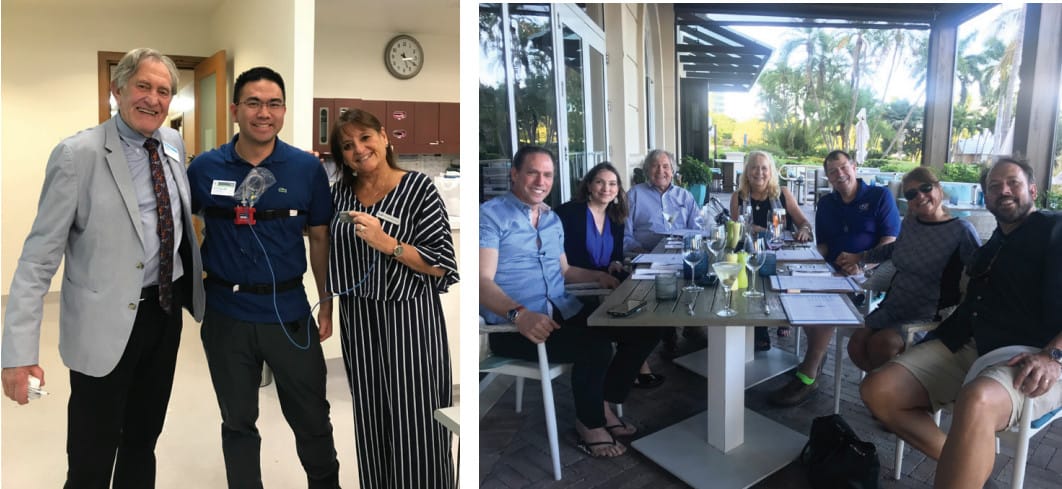Dr. John Remmers says to keep a sharp eye when data points to a different path. Read his interview with DSP and find out how he thinks clinicians can use current evidence to guide therapy and ultimately serve community health.
 An Interview with Dr. John Remmers
An Interview with Dr. John Remmers
Evidence drives the best medical decisions. Therapy changes when the evidence leads us to see things differently. When the data points to a different path, treatment follows, but the old protocols are not thrown out. Think of it like changing lenses on glasses – a more precise shape provides better vision, but the frames stay the same.
John Remmers, MD, has been part of all the changes in sleep medicine. As a young physician, he discovered the collapse of the upper airway that resulted in breathing interruptions being named “obstructive sleep apnea” (OSA) in 1978. For 22 years, following a conference he chaired in Chicago, the AHI, apnea-hypopnea index, was the defining term, the evidence, used by medicine to label and evaluate disease and the means to treat it.
In 2000, another Chicago conference changed everything when studies, some led by Dr. Remmers, began to show that AHI was an insufficient marker. A gap widened between AHI measurements and patient-reported symptoms. Medicine came to a break point. New definitions were needed.
Balancing the 22 years between discovery and 2000 with the same number of years since, Dr. Remmers is retired from clinical practice but as involved as ever in pushing the treatment of OSA to better outcomes. He has a lot to say about how clinicians can use current evidence to guide therapy and ultimately serve community health.
DSP: Dr. Remmers, what’s new in our understanding of OSA since the beginning?
JR: From 1978 to the year 2000, most of us thought about sleep apnea as a disease of old fat guys – we understood the airway closure, we had a treatment that worked, everything was cool. Two things happened in 2000: The Wisconsin Sleep Cohort showed two really important things. It wasn’t just old fat guys – up to 10% of all adult males had a high AHI – that was staggering, scary. The other thing it showed was only half of them were sleepy! The other thing that happened in 2000 was the second conference in Chicago. Dr. Guilleminault’s AHI scale, which was supposed to give us the way to describe everyone with OSA, lost the correlation between the scale number and whether the patient felt good – were they sleepy or tired. I’ll never forget standing next to my poster and having Phil Westbrook ask: “What’s going on here? Why are all these people not sleepy?”
We also noticed some patients with tracheostomy also stopped breathing. No obstruction there, so what’s going on? This was named ‘central sleep apnea’ – a new term.
Our tidy, easy, sleep field was disrupted.
What’s happened since 2000? Once we started looking at epidemiologic data we found evidence of premature death in people with OSA – this is a bad disease. More and more people were turning up with OSA in our population, so we knew we really had to get a handle on it. With obesity, the numbers were getting crazy – with so many diagnosed, is this really a disease?
Some people had AHI over 100 that didn’t seem too sick. Is AHI a good way to describe OSA?
Is the airway the only thing that matters? Some giants of research looked at this and realized the anatomy might influence other responses – there were measurements to be defined. The concept of endotypes – how easy are you to arouse, what is your sensitivity to oxygen changes, how long does it take for the muscles to respond? This wasn’t my work – I missed it. I think dentists didn’t get it, either – they like to think about airway. It’s important, but not the whole story – there are neural factors determining what the AHI is and the response to therapy.
The oxygen signal is a great one – I’ve been a fan for decades.
CPAP, for example, works better because it not only opens the collapse of the airway, but it increases the lung volume and oxygen balance, but it also addresses some of the neurologic factors, particularly high loop gain. Maybe oral appliances don’t work as well because they can’t help loop gain. Not every dentist, physician, or the ones that teach others, appreciate the connections between airway and the neurologic factors.
AHI, then is a failure – it just doesn’t take enough of the evidence that’s come out since 2000 into account. Better is what results from the closed airway – the effect on oxygen. We have another index, ODI (oxygen desaturation index) that is better than AHI. It leads us to be able to measure Hypoxic Burden (HB) – and that factor predicts death from cardiovascular disease. Now we’re doing something smart.
In fact, this sentence ought to be over the door of your office and my office: “Unlike AHI, Hypoxic Burden predicts Death, from all causes, including cardiovascular disease”. That’s pretty cool – we have a better index. AHI was created by Dr. Guilleminault by observing events – their importance was a set of a priori assumptions. These years later, we think about what happens to the person because of the obstructions and we have evidence to connect with outcomes.

DSP: Keeping airway as a focus, then, or, more accurately, managing everything from the perspective that keeping the airway from collapse, is not enough.
JR: That’s it! We kind of fell into it with CPAP. Knowing it could prevent collapse, we used it and later we found out it hammers the loop gain – a benefit we didn’t know about before 2000. Smart researchers from Harvard, and Magdy Younes before them, were learning about how the brain and respiratory centers respond to oxygen.
I got started with dentists in 1984 – and it was a neurophysiologist that invited me to a conference at University of British Columbia to talk about the new disease I had discovered. The scientist was studying airway muscles and thought he might have a handle on how to keep the airway from collapsing. The researcher turned out to also be an orthodontist, Dr. Alan Lowe. I helped fund clinical trials of stents, we called them, to see if the airway could be kept open – we used thermosensors, did randomized control trials and compared them to CPAP. I helped direct Canadian federal funds and some industry money to develop what came to be the Kleerway. I met Keith Thornton about the same time, worked with him on the TAP, all while thinking airway collapse was the thing that needed to be prevented and the patient would get the same benefit as CPAP.
After 2000, even though we knew CPAP had these good outcomes, the epidemiology clearly showed that polysomnography and CPAP wasn’t going to be able to keep up with the expanding population that needed our help. The first home sleep apnea test devices and auto-adjusting PAPs came from me. Neither of these were well-received by the medical community, and, along with my work with dentists, caused me to be rejected by most of medicine. Look at today, though, with HSAT and autoPAP being most of the testing and treatment and I guess I was right.

DSP: Please tell me your thoughts on dentist-physician collaboration going forward. What does the next 22 years look like?
JR: We have sleep docs who are keeping their heads down, ignoring all the evidence that CPAP is not getting results we expected from pre-2000 thinking. We can’t continue ignoring research that shows that CPAP lacks evidence to support long term desired outcomes – reduced sleepiness, longer lives, less cardiovascular mortality. Medicine must try something different if we want to have any hope. Oral appliances are probably part of the answer, but we lack evidence there, too. I’m trying to change that and get FDA to approve manufacturers to be able to recommend mandibular advancement for all AHI levels – there’s no clear superiority any more for CPAP so why not? By the way, any clinician can use OAT for any level of AHI – for severe, it’s just ‘off label’ use – something we do in medicine all the time.
The big problem physicians have with dentists, and I’ve talked with lots of sleep docs as part of what I’m doing these days, is lack of control of the patient care plan. They think first that oral appliances don’t work and second that losing control to dentists will hurt their patient outcomes.
Like we’ve been talking about, airway is a big part of the problem – the collapse of the oropharynx that I found in 1978, but since 2000 the neurologic components are showing up to be just as important. There’s more to treatment than holding the jaw forward! What I’m kind of curious about is whether the differences in appliances might be part of it – does a metal hinge vs. a smooth milled device result in different outcome because of the design itself. Not just the amount of protrusion, but the actual way they function. Need to study that. Not ready for clinical recommendation yet, no evidence, but I’m curious. Something to think about.
DSP: What about using some of the new technology, with shared portals for data. Will that make it work better?
JR: It could, if the sleep doc sees the patient annually or so, and the sleep dentist pays attention to the data. If things are not going well, or if the patient is getting off course with compliance or has residual events, the dentist should be actively involved with the patient. Just like it’s no good for a sleep doc to hand out a CPAP and “See ya later,” that’s no way for a dentist to use oral appliances, either.
The oxygen signal is a great one – I’ve been a fan for decades. We can get it from many places – the company I’m working with now is developing technologies that combine oxygen data gathering and oral devices in a way that is useful for sleep docs and dentists. Talk about being able to monitor for results!
The medical profession, sleep docs and dentists, needs to look to the next 22 years and be able to say we’ve learned. We want to make a difference in longevity, sleepiness, and death from cardiovascular disease. Technology and a closer working relationship looks like the best way we can use the evidence we have now to make that happen. Who knows, though, what we’ll say after 22 more years?
Read “What’s the Problem with Oral Appliance Therapy for Obstructive Apnea?” to find out what Dr. John Remmers thinks about CPAP versus OAT and the influence of doctors on OSA therapy: https://dentalsleeppractice.com/whats-the-problem-with-oral-appliance-therapy-for-obstructive-apnea/




